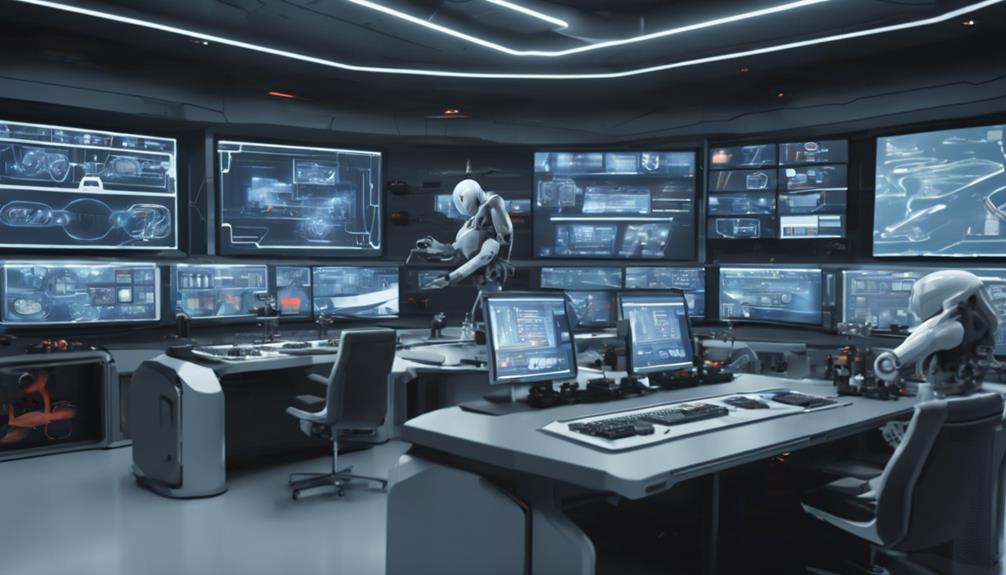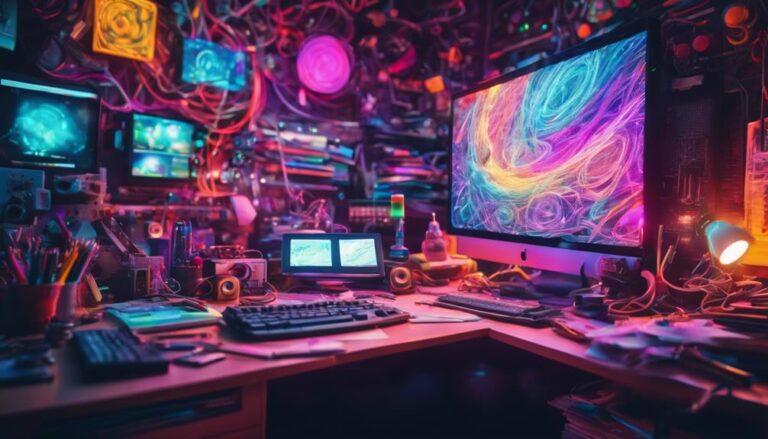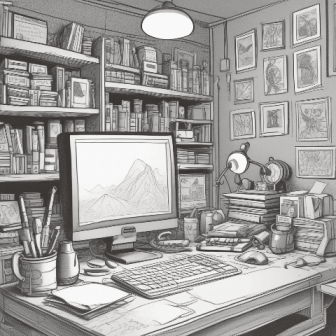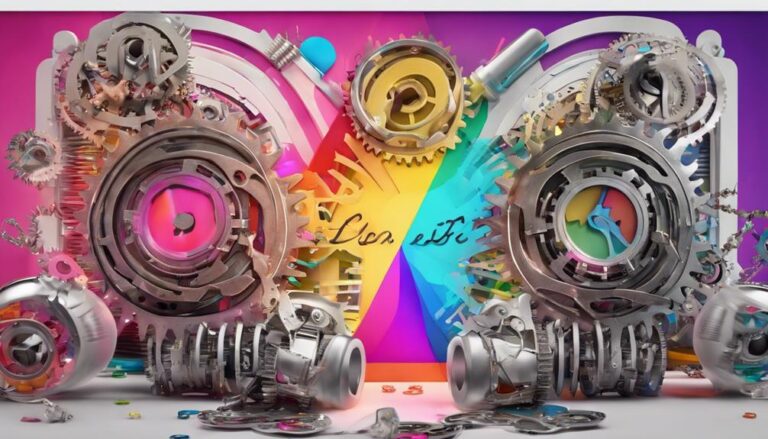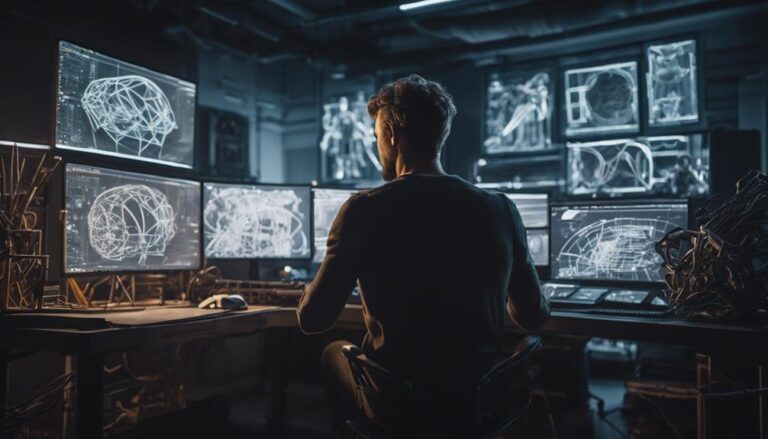Engineering Animation
You're likely using engineering animation to convey complex design ideas, enhance collaboration among stakeholders, and communicate product functionality. Various types of engineering animations, such as motion graphics, 3D product animations, and virtual reality (VR) and augmented reality (AR) animations, cater to specific needs and applications. Engineering animation software like Autodesk Inventor, SolidWorks, and Blender enable the creation of detailed simulations and models. By creating engaging animations using storytelling techniques and clear language, you can improve design communication and clarity. Now, you can discover how to create effective animations that help you streamline your workflow and improve product quality even further.
Key Takeaways
- Engineering animation improves design communication, facilitating efficient conveyance of complex ideas to stakeholders and cross-functional teams.
- Types of engineering animation include motion graphics, 3D product animation, exploded view animations, and virtual reality (VR) and augmented reality (AR) animations.
- Engineering animation is used in technical documentation, instructional videos, presentations, product design visualization, and industrial training simulations.
- Benefits of engineering animation include enhanced collaboration tools, design clarity, and visual storytelling, enabling the illustration of design intent and function.
- Software options like Autodesk Inventor, SolidWorks, and Blender cater to specific needs, providing 2D and 3D modeling capabilities for engineering animation.
Types of Engineering Animation
When creating engineering animations, you'll often come across various types that cater to specific purposes and industries.
Technical storytelling is a crucial aspect of these animations, as it enables you to convey complex information in an engaging and easily understandable manner.
Motion graphics is one type of engineering animation that focuses on visualizing data, such as 2D and 3D animations of mechanical systems or processes.
This type is widely used in technical documentation, instructional videos, and presentations.
Another type is 3D product animation, which allows you to showcase product features, functionality, and interactions in a highly detailed and realistic environment.
Exploded view animations and assembly/disassembly animations are also common types of engineering animations.
These animations help illustrate complex product structures and assembly sequences.
Additionally, virtual reality (VR) and augmented reality (AR) animations are being increasingly used in the field of engineering animation.
These types of animations provide immersive experiences and enable users to interact with virtual products or environments in real-time.
Benefits for Design Teams
As you integrate engineering animation into your design workflow, you'll notice significant improvements in design communication, allowing you to efficiently convey complex ideas to stakeholders and cross-functional teams.
This, in turn, enables enhanced collaboration tools, facilitating real-time feedback and reducing errors throughout the design process.
Improved Design Communication
By integrating engineering animation into your design workflow, you can significantly enhance design communication among team members.
This improvement is largely due to the ability of animations to convey complex design data in an intuitive and easily understandable format. With engineering animation, you can break down intricate design concepts into simpler, more digestible visual elements, thereby ensuring that all team members are on the same page.
Engineering animation facilitates design clarity by allowing you to illustrate the relationships between various components and how they interact within a system.
This clarity is essential for effective design communication, as it enables team members to quickly grasp and analyze complex design data. Additionally, engineering animation is a powerful tool for visual storytelling, enabling you to illustrate design intent and communicate the intended function of a product or system.
Enhanced Collaboration Tools
Engineering animation extends its benefits beyond design communication, enabling you to rethink the way you collaborate with your team.
By leveraging enhanced collaboration tools, you can streamline your workflow, reduce errors, and increase productivity. Virtual Reality (VR) and Augmented Reality (AR) technologies play a significant role in facilitating immersive collaboration experiences.
You can use VR to create interactive 3D models that allow team members to visualize and interact with designs in real-time.
Data Integration is another crucial aspect of enhanced collaboration tools.
By integrating data from various sources, you can create a centralized platform for data sharing and collaboration. This enables team members to access and share data in real-time, reducing errors and miscommunication.
Engineering animation software can be integrated with popular data management tools, such as Product Lifecycle Management (PLM) and Computer-Aided Design (CAD) systems.
This integration enables you to collaborate more effectively with cross-functional teams, including design, engineering, and manufacturing.
Key Industries and Applications
In your work with engineering animation, you'll notice that key industries and applications are leveraging this technology to enhance their operations.
Product design visualization is one major area where engineering animation is applied, enabling designers to test and showcase product prototypes in a virtual environment.
Additionally, industrial training simulations are another significant application, allowing operators to practice complex procedures in a safe and controlled setting, reducing the risk of accidents and improving overall efficiency.
Product Design Visualization
Product Design Visualization
Typically, product design visualization is a crucial step in the development process for manufacturers, allowing you to evaluate and refine your designs before investing in production.
This stage is critical in the design process, as it enables you to identify and rectify potential issues, reducing the risk of costly rework and improving overall product quality.
During the design process, visual prototyping plays a key role in product design visualization.
By creating interactive 3D models, you can explore different design options and test their functionality in a virtual environment.
This approach helps you to validate design assumptions, assess usability, and optimize product performance.
Product design visualization is widely used in various industries, including automotive, aerospace, and industrial equipment manufacturing.
It facilitates collaboration among cross-functional teams, such as design, engineering, and manufacturing, ensuring that everyone is aligned with the design intent.
By leveraging product design visualization, you can streamline the design process, reduce time-to-market, and improve overall product development efficiency.
Effective visualization techniques enable you to create high-quality, production-ready designs that meet customer expectations and stay competitive in the market.
Industrial Training Simulations
Effective industrial training simulations play a critical role in preparing operators for complex tasks, ensuring you're equipped to handle a variety of scenarios in high-stakes industries.
These simulations replicate real-world environments, allowing you to practice and refine your skills without risking damage to equipment or compromising safety.
In industries such as aerospace, energy, and manufacturing, training scenarios are designed to mimic critical situations, such as equipment malfunctions or emergency shutdowns.
Virtual mentors guide you through these simulations, providing personalized feedback and assessment.
These digital instructors identify areas where you need improvement, offering targeted training and support.
By leveraging industrial training simulations, you can develop the skills and confidence needed to operate complex systems and equipment safely and efficiently.
Industrial training simulations are widely used in industries where human error can have serious consequences.
By simulating real-world scenarios, you can develop muscle memory and critical thinking skills, reducing the risk of accidents and improving overall performance.
As technology continues to evolve, industrial training simulations will play an increasingly important role in preparing operators for the demands of high-stakes industries.
Animation Software and Tools
With the rise of computer-aided design (CAD), engineering animation relies heavily on specialized software and tools to create, edit, and visualize complex simulations.
You'll need to choose from a range of software options that cater to your specific needs, such as Autodesk Inventor, SolidWorks, and Blender. These tools provide 2D and 3D modeling capabilities, allowing you to create detailed simulations of mechanical systems, fluid dynamics, and other engineering applications.
When selecting software, consider factors such as compatibility, scalability, and user interface.
You should also stay up-to-date with the latest animation trends, including the use of physics-based simulations, motion capture, and data-driven animation. Many software options offer advanced features, such as real-time rendering, dynamic simulations, and virtual reality (VR) integration.
Popular animation software, including Maya and 3ds Max, offer robust toolsets for creating and editing animations.
As you explore different software options, consider factors such as cost, learning curve, and support resources.
Best Practices for Creation
How do you create engineering animations that accurately convey complex systems and processes, while also engaging your audience and promoting clarity?
To achieve this, it's essential to incorporate storytelling techniques into your animations.
Start by defining your message and identifying your target audience. This will help you tailor your animation to their needs and interests.
Use clear and concise language in your script, avoiding technical jargon whenever possible.
When designing your animation, consider current animation trends, such as the use of 3D models and realistic textures.
These elements can help create a more immersive experience for your audience.
Additionally, use visual effects judiciously, as too many can distract from the main message.
Organize your animation into logical sections, using transitions to guide the viewer through the narrative.
Use color and lighting to highlight important components and processes.
Real-World Success Stories
Numerous companies have successfully leveraged engineering animations to convey intricate systems and processes to their audiences.
You can draw inspiration from case studies of companies like Siemens and GE, which have used animations to demonstrate complex engineering concepts and products.
By examining their approaches, you can identify strategies for creating effective animations that engage and inform your audience.
Animation pioneers like Pixar and Lucasfilm have also made significant contributions to the development of engineering animation.
Their innovations in areas like computer-generated imagery (CGI) and motion capture have enabled the creation of sophisticated animations that can accurately depict complex engineering systems.
By studying the techniques used by these companies, you can gain insights into how to apply similar methods to your own animations.
As you explore these success stories, you'll see how engineering animations can be used to communicate complex ideas, facilitate training, and showcase products.
Future of Engineering Animation
The future of engineering animation promises to be shaped by several emerging technologies that will significantly impact its development and application.
As you explore this field, you'll notice the increasing importance of Virtual Reality (VR) and Artificial Intelligence (AI) integration. VR will enable you to immerse yourself in simulated environments, allowing for more realistic testing and validation of engineering designs.
This will reduce the need for physical prototypes and accelerate the product development process.
AI integration will also play a crucial role in the future of engineering animation. You'll be able to leverage machine learning algorithms to automate tasks such as data analysis, simulation, and visualization.
This will enable you to focus on higher-level tasks, such as design optimization and decision-making. Additionally, AI-powered tools will help you identify potential design flaws and suggest improvements, leading to more efficient and effective engineering processes.
As you adopt these emerging technologies, you'll be able to create more accurate, realistic, and detailed animations that drive innovation and growth in various industries.
Frequently Asked Questions
What Is the Ideal Frame Rate for Engineering Animations?
When creating animations, you aim for a frame rate that balances visual fluidity and file size. Typically, you'll optimize for 24-30 frames per second, ensuring smooth motion and efficient rendering for optimal visual impact.
Can Engineering Animations Be Used for Patent Filings?
When filing patents, you can use patent visualization tools, including technical illustrations, to effectively communicate complex ideas. These visuals, when created as animations, can further enhance your patent application by providing dynamic, step-by-step explanations.
Are Engineering Animations Suitable for All Types of Projects?
You assess project complexity to determine if animations suit your needs. While they're effective for simple to moderately complex projects, they may not be ideal for highly complex ones, but can aid in stakeholder buy-in.
How Do I Protect My Animations From Copyright Infringement?
To protect your animations from copyright infringement, you're using watermarking techniques and displaying legal disclaimers on your work, clearly stating ownership and rights, and registering your animations with the relevant copyright offices, don't you?
Can Engineering Animations Be Created Without Coding Knowledge?
You can create animations without coding using design tools and animation software. Many programs offer drag-and-drop interfaces and pre-built templates, allowing you to focus on visual elements and storytelling, rather than writing code itself.
Conclusion
As you integrate engineering animation into your workflow, you'll see enhanced design processes and improved communication. You'll create interactive visualizations that simplify complex concepts and facilitate data-driven decision-making. By leveraging the right software and best practices, you'll stay ahead of the curve. With its versatility and increasing adoption across industries, engineering animation will continue to play a vital role in the future of product design and development, driving innovation and excellence.

